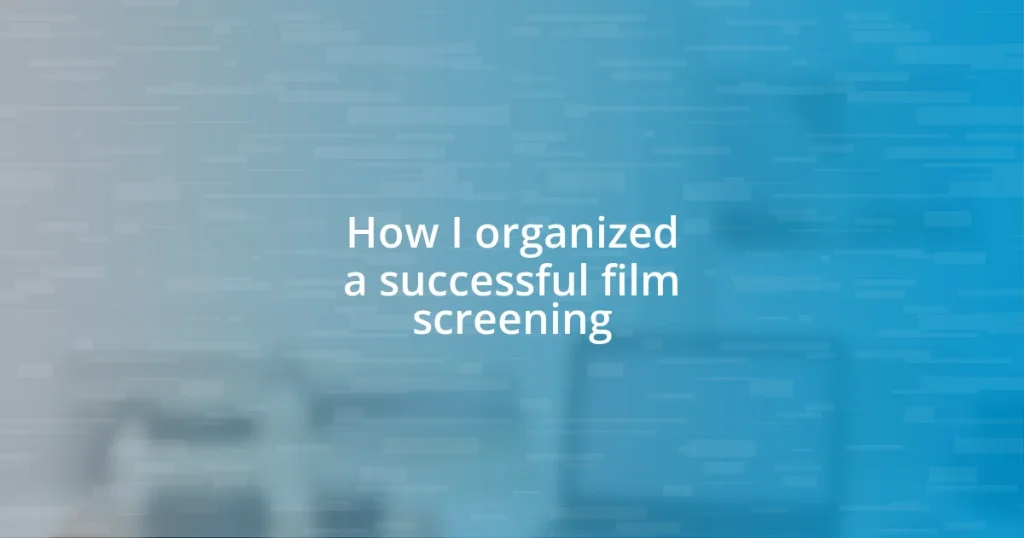Key takeaways:
- Setting clear, specific, and measurable objectives is crucial for guiding the event planning and aligning actions with goals.
- Choosing the right venue enhances the audience experience and involves considerations like capacity, accessibility, atmosphere, equipment, and cost.
- Engaging with the audience through introductions, Q&A sessions, and interactive activities fosters a sense of community and enhances the overall event experience.

Setting clear objectives
When I embarked on organizing my first film screening, setting clear objectives was my guiding compass. I vividly remember sitting down with a cup of coffee, jotting down what I wanted to achieve: Was it to increase awareness of independent filmmakers? Connect with local artists? Or simply share a story I believed in? Defining my goals helped me align my actions and decisions throughout the planning process.
I also realized that my objectives needed to be specific and measurable. For instance, rather than just aiming to fill the seats, I wanted to engage at least 50 attendees and gather feedback for improvement. This kind of clarity really excited me—knowing I could measure success made it feel attainable. Have you ever set a goal and felt that adrenaline rush when you realized it was doable? That moment propelled me forward.
As the screening date neared, I found myself reflecting on whether my objectives still resonated with me. I recall asking myself, “Am I still committed to creating a space for dialogue about the film?” This introspection ensured that my initial intentions remained at the forefront, enhancing the overall experience for both me and my audience. There’s something deeply fulfilling about aligning your actions with your deepest aspirations, wouldn’t you agree?

Choosing the right venue
When it came to selecting the right venue, I felt it was crucial to find a space that not only fit my vision but also complemented the film itself. I still remember the thrill of walking into a quaint local theater that radiated character. The vintage marquee and plush red seats instantly drew me in—it felt like the perfect backdrop for sharing stories. Choosing a venue that resonates emotionally with your audience can really elevate the experience.
Here are a few key points I considered while choosing my venue:
- Capacity: Ensure it can comfortably hold your anticipated crowd. Too big, and it might feel empty; too small, and it’s cramped.
- Accessibility: The venue should be easy to reach for everyone, with ample parking or public transport options.
- Atmosphere: Look for a place that conveys the right vibe—whether it’s cozy and intimate or grand and impressive.
- Equipment: Check if they have the necessary screening equipment and a good sound system.
- Cost: Be mindful of your budget, considering what amenities come with the rental fee.
Taking the time to evaluate these aspects helped me establish a space where the audience could fully immerse themselves. I wanted them to feel the excitement of being part of something special, and I believe the right venue plays a pivotal role in achieving that.

Selecting the film to screen
Selecting the film to screen is one of the most enjoyable parts of the organizing process. It reminds me of picking the perfect gift for a friend; you want it to resonate, surprise, and spark a conversation. I leaned towards films that not only matched my objectives but also would spark engagement among the audience. Ultimately, I chose an independent film that showcased local talent. I felt a deep connection to the story, and I hoped the audience would feel it too.
When I narrowed down my choices, I created a simple criteria checklist that helped me decide. This included the film’s themes, target audience, and potential for audience interaction. For instance, I envisioned how certain narratives could lead to discussions post-screening. Did I want the film to provoke thought, provide entertainment, or inspire change? This kind of strategic thinking was pivotal in my decision-making process.
I also took time to watch trailers and read reviews, but the most valuable insights came from watching the films themselves. Each film evoked something different in me. The right film not only has to engage the audience; it must also resonate with the organizer’s passion. So, I asked myself, “Which film sets my heart racing, and which story do I feel compelled to share?” That emotional connection became my guiding light, allowing me to confidently select a film that I felt would leave a lasting impact.
| Criteria | Considerations |
|---|---|
| Theme | Does it align with audience interests? |
| Engagement | Potential for discussion and interaction? |
| Emotional connection | How does it make me feel? |

Promoting the event effectively
To promote my film screening effectively, I realized that reaching my target audience required a blend of creativity and strategy. I began by leveraging social media platforms, which have an incredible ability to generate buzz. By crafting engaging posts and visually appealing graphics, I caught the eye of potential attendees. I remember the rush I felt when our movie trailer went viral; it showcased not just the film but also our communal efforts.
I also reached out to local influencers and community groups that aligned with the film’s themes. After all, word-of-mouth recommendations can be incredibly powerful. I still smile at the memory of a local blogger who not only attended but also live-tweeted her experience during the screening. That personal touch made others curious and excited to join in, turning my event into a must-see gathering.
Additionally, I decided to create an email list to keep interested parties informed. I sent out sneak peeks, behind-the-scenes content, and even polls asking what the audience wanted to learn post-screening. It was during those moments of engagement that I genuinely felt connected to my audience. After all, who wouldn’t want to feel included in the creative process of sharing a film?

Coordinating logistics and setup
Coordinating logistics and setup often feels like piecing together a puzzle—each element needs to fit just right. I recall the adrenaline rush I felt when securing the venue; it was an old theater dripping with character, and as soon as I walked in, I knew it was the perfect backdrop for my film. In my experience, the choice of venue can set the tone for the entire event, and I wanted to create an inviting atmosphere that would resonate with the audience.
I made a detailed checklist to oversee everything from seating arrangements to technical setups. I found that visiting the venue beforehand was invaluable! The process allowed me to visualize where everything would go and ensure the layout was conducive to engagement. I remember thinking, “How will people interact in this space?” Ensuring that every seat had an unobstructed view helped foster a more connected experience during the screening. Simple things, like setting up a cozy area for post-film discussions, made all the difference, turning an event into a memorable gathering.
As the day approached, there were moments of anxiety mixed with excitement. I collaborated closely with the projectionist to test the sound and visuals, as I knew a flawless presentation could elevate the audience’s experience. Watching the film on the big screen for the first time gave me butterflies. What if something went wrong? Yet, I had prepared as thoroughly as possible, and with each click of the projector, my anticipation grew. Ultimately, the logistics were not just about the technicalities; they were about creating an environment where viewers felt a sense of community.

Engaging with the audience
Understanding how to engage with the audience during a film screening can transform the entire experience. When the lights dimmed and the film started, I could sense the collective anticipation from the crowd, and it struck me how vital it was to nurture that energy. I made it a point to introduce the film briefly, sharing a heartfelt story behind its creation. This not only built a connection but also gave viewers a deeper context as they settled in. Reflecting on that moment, I realized how important it is to create that bridge between the audience and the film.
After the screening, I organized a Q&A session, which turned out to be one of my favorite parts of the event. I still remember the excitement of hearing audience members share their interpretations and asking questions about certain scenes. Engaging in that dialogue felt like a gift; it was an opportunity to explore different perspectives and emotions tied to the film. I found that letting my audience voice their thoughts not only validated their experiences but also encouraged a sense of belonging within the community created that night.
To elevate engagement further, I set up interactive activities related to the film’s theme. For instance, I arranged a small creative space where attendees could draw or write about their reflections inspired by the movie. Watching people immerse themselves in this experience made my heart swell with joy. I thought, “Isn’t this what art should do—ignite creativity and conversation?” It was gratifying to see that spark of interest flourish, reminding me that engaging the audience goes beyond just the film; it’s about fostering connections that can last long after the credits roll.

Gathering feedback for improvement
Gathering feedback is a crucial step in refining my craft and enhancing future screenings. After the event, I took a moment to sit down with a few audience members to ask their thoughts. It felt a bit daunting at first—what if they didn’t like it? However, their insights turned out to be invaluable. Someone mentioned they struggled with the pacing in one section, and that sparked a lively conversation about editing choices. Their honesty made me realize how vital it is to be receptive to constructive criticism, as it opens the door to improvement.
I also set up an online survey for attendees, which was a game-changer. It allowed those who were shy in person to express their opinions more freely. In reading through their responses, I found some surprising gems! For instance, several viewers enjoyed a subplot I initially considered cutting. I think it’s fascinating how different perspectives can illuminate aspects of the film I hadn’t fully appreciated. Reflecting on that experience made me appreciate the importance of creating a safe environment for feedback.
Moreover, during our discussions post-screening, I often found myself jotting down notes on specific comments made by the audience. This practice became a habit—like keeping a journal of thoughts from a diverse group of people. Sometimes, I’d catch myself smiling at their enthusiasm or intense debates over particular scenes. Listening to their opinions not only fueled my passion but also inspired ideas for my next project. Isn’t it incredible how a simple conversation can spark creativity and improvement?
















